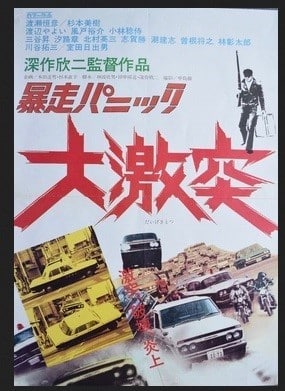A series of daring bank robberies makes headlines all over western Japan. The modus operandi of the pair of robbers is always the same: they arrive in a car stolen in Osaka, they enter the bank fully masked and with gun in hand, they jump up onto the counter (no protective glass walls there at the time), fire shots into the ceiling and grab all the cash they can quickly get their hands on. Millions of yen each time, in Nagoya, in Otsu, in Kyoto.
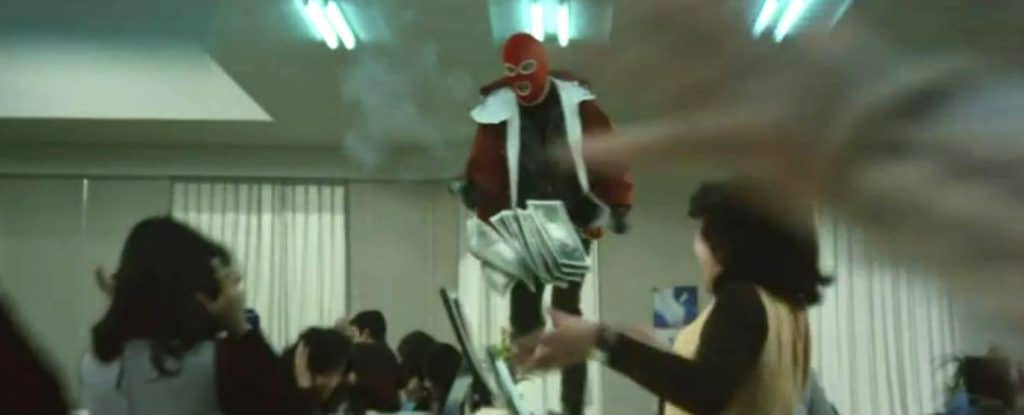
The two robbers are Takashi Yamanaka (Tsunehiko Watase) and Mitsuo Seki (Nenji Kobayashi) and they have a clear objective: taking as much cash as possible before retiring to Brazil. They already got their passports, visa and air tickets ready. One last big coup and they will be on their way.
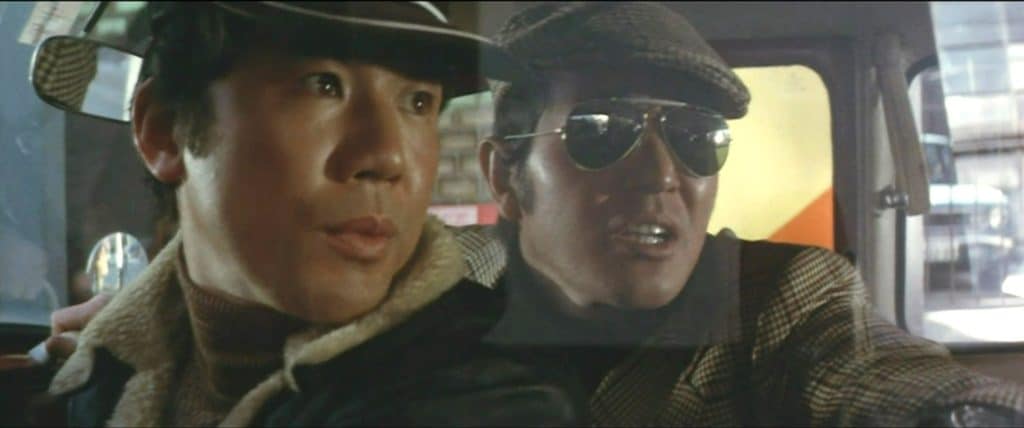
They carefully scout out a large bank in Kobe, then they hit. The robbery goes off without a glitch but then disaster strikes. On their getaway run, Mitsuo gets hit by a motorbike, the impact throws him under a moving truck. He dies instantly. Takashi manages to escape with a part of the loot.
Takashi works in an America-style bar in Osaka, he lives in the city with his somewhat annoying girlfriend Michi Midorikawa (Miki Sugimoto). Takashi had saved Michi from a lecherous drunk at the bar some time prior. Once she moved into his place, visits by the police became frequent – Takashi got asked again and again to bail out Michi when she got caught shoplifting expensive clothes, he always ended up buying the outfits for her.
Michi on the other hand doesn’t know about Takashi’s robberies, she doesn’t know about his plans to go to Brazil.
Osaka police quickly identify the killed Mitsuo, search his apartment and find there the clues they need to pursue the second robber. The manhunt for Takashi is on. Not without a focus on super-horny Officer Hatano (Takuzo Kawatani) and his escapades with female fellow Officer Kuriyama (Yayoi Watanabe).
This is a Toei Studio Pinky Violence movie after all, incorporating plenty of bare female breasts along with all the violence.
Takashi has all packed up, passport ready and a large bag with all the cash from the various bank heists. Just then, the brother of his killed partner Mitsuo shows up and demands the loot from the Kobe robbery. A fight erupts, Takashi makes his escape, stealing a truck stacked with sacks of rice. Mitsuo’s brother manages to climb up on the back of the truck, wildly firing a gun and a first wild car chase with the police follows.
Table of Contents
Violent Panic: The Big Crash (Japan, 1976) 暴走パニック 大激突
Just as the title of the movie has two parts, Violent Panic and The Big Crash, Boso panikku: Dai Gekitotsu being the Japanese title, the movie itself feels like having two distinctive parts. The first part being about the robberies, Takashi’s relationship with Michi, plus adding a few substories barely relating to the main plot (including a homosexual torture session leading to murder), might somewhat qualify as a more or less serious gangster movie.
The second part is of a totally different caliber, however. Having lost his big bag of money, Takashi needs to commit a new robbery to replenish his cash. He goes for the Sumitomo Bank branch on the first floor of the old Daiichi Semei building in Umeda, Osaka. The bank is however already under surveillance by both Officer Hatano and Mitsuo’s brother. Once Takashi runs out of the bank and jumps into his getaway car, both Officer Hatano in his patrol car and Mitsuo’s brother follow in hot pursuit.
The resulting car chase, taking up the second half of the movie, has to be seen to be believed. Both the police car and Mitsuo’s brother’s tow truck ram other vehicles on their way. The drivers of those cars, in turn, join the chase. More cars get rammed, more cars join the chase. A motorbike gang member gets run over, so the whole biker gang joins in as well. A TV reporter excitedly comments on it all live on air while becoming part of the chase himself, his TV van taking multiple hits by the other cars involved.
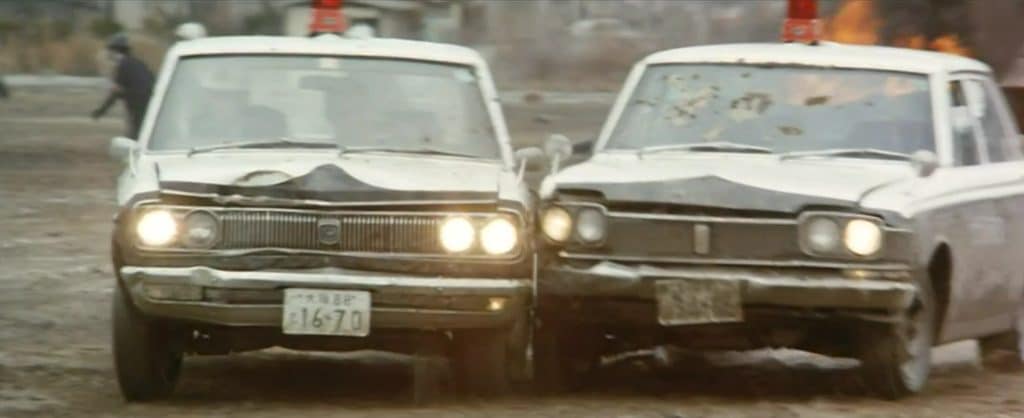
According to the movie’s trailer, 200 cars were involved in the filming of that chase. Takashi (by then with Michi in his car) tries to get away. Officer Hatano and Mitsuo’s brother try to hunt him down. The rest of all the 200 cars and bikers just keep on hitting each other, not knowing what’s really going on. It’s pure madness, car crashes left and right, cars going up in flames, people getting bloodily run over, the TV reporter rapidly talking into his microphone in the midst of it. It gets to unbelievably mad, the movie just becomes a comedy, sort of.
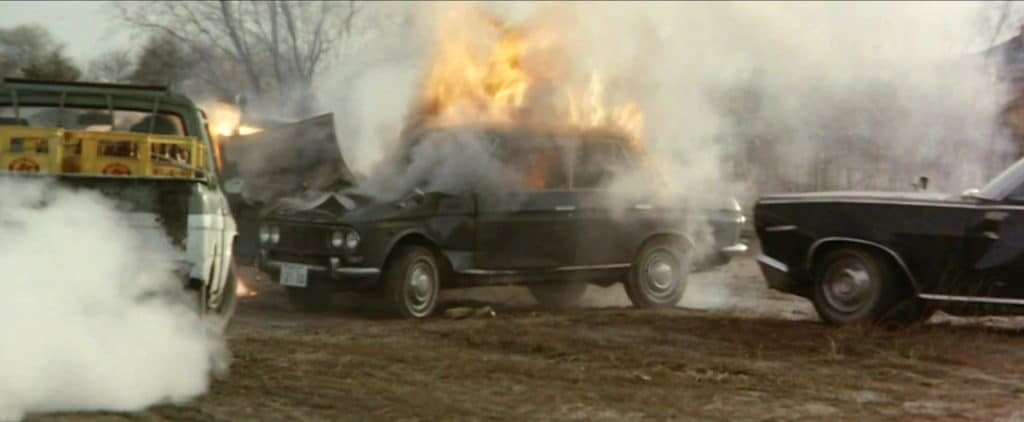
Will Takashi and Michi get out of there alive? Will they make it to Brazil, getting rich by committing another bank heist there? You will have to watch the movie by yourself to find out.
Toei’s Pinky Violence
While pink movies (Japanese sex films) in general, and major Nikkatsu Studio’s Roman Porno productions in particular featured all sorts of stories, extended sex scenes where always the main selling point.
Toei Studio’s Pinky Violence films however focused on action and violence instead of sex. The films featured plenty of female nudity and (usually brief) sex scenes were liberally thrown in but they were not the main attraction. Action and violence took center stage, sex was just the salacious part of the violent action.
The Director: Kinji Fukasaku
Kinji Fukasaku (1930 – 2003) was a very versatile director, working in many genres ranging from yakuza crime flicks to action movies to serious drama.
All of his films display however a highly charged level of energy. Things tend to get gritty, dirty and violent fast in any Fukasaku movie, no matter the genre.
Fukasaku became a major movie director with his Battles Without Honor and Humanity series (1973 – 1976) depicting yakuza turf wars in post-war Hiroshima and later Osaka.
With the epic Virus (1980), Fukasaku made the up to then most expensive Japanese movie production, an international feature largely shot in English and starring Sonny Chiba, George Kennedy, Robert Vaughn and Olivia Hussey.
Late in his career, Fukasaku had his international break-out success with the controversial Battle Royale (2000), starring Takeshi Kitano.
Tsunehiko Watase
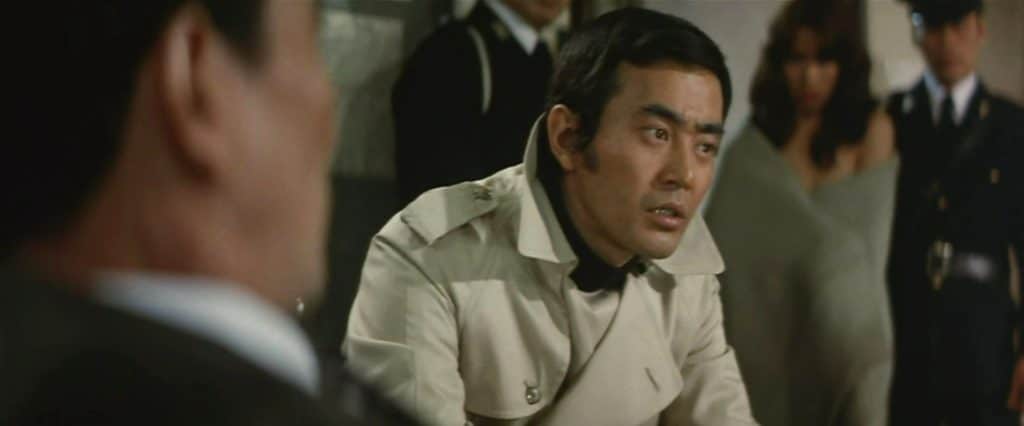
Bank robber Takashi Yamanaka is played by Tsunehiko Watase (1944 – 2017). Born in Shimane Prefecture, Watase grew up in Hyogo Prefecture, neighboring Osaka. In his high school years, Watase received a black belt in judo. Later, while studying law at Waseda University in Tokyo, he was a second dan in karate.
His elder brother Michihiko was already an actor and he warned his younger brother that acting is precarious work. Michihiko later became a famous actor under the pseudonym Tetsuya Watari.
Tsunehiko Watase entered Toei Studio anyway and was casted there in a large number of yakuza crime action movies, including Kinji Fukasaku’s Battles without Honor and Humanity series (acting there from 1973 to 1975).
Watase became a regular in Kinji Fukasaku’s gritty high energy crime capers and was soon regarded as one of Japan’s top action movie actors. His athletic background in judo and karate certainly helped to attain that status.
Watase was also a daredevil driver. In Violent Panic: The Big Crash, he was the only actor who did all the crazy driving himself, even in the wildest moments of the car chases. Even with the car door being ripped out. All other actors used stunt doubles.
That wild driving continued when he filmed the yakuza action thriller Hokuriku Proxy War (1977), another Kinji Fukasaku movie. He got thrown out of an open jeep and had a leg crushed.
Watase had to abandon his action career and became a serious character actor, also taking on more TV jobs with progressing age.
Miki Sugimoto
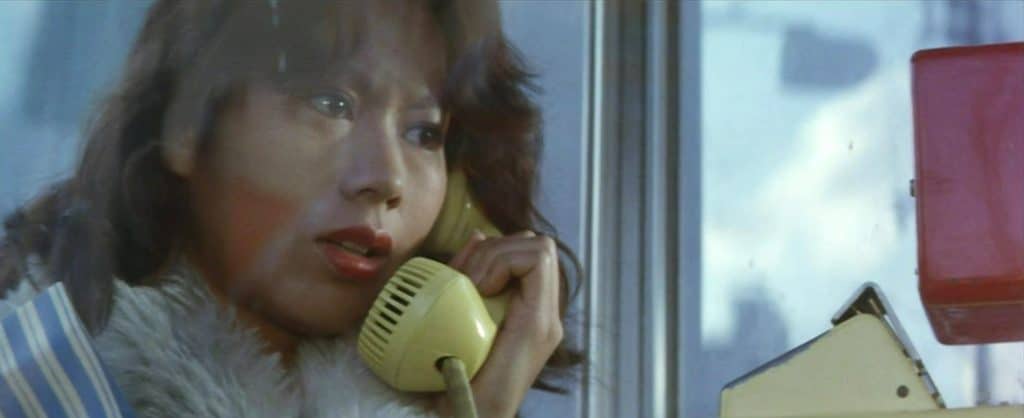
Miki Sugimoto, playing the role of Takashi’s love interest Michi Midorikawa, was frequently casted as the delinquent girl in Toei Studio’s Pinky Violence movies. Born in 1953 in Kanagawa Prefecture, Sugimoto started out in Toei’s 1971 Hot Spring Mimizu Geisha alongside Reiko Ike. Sugimoto and Ike partnered as bad girls in a number of Toei Pinky Violence movies before Sugimoto struck out on her career-defining solo work Zero Woman: Red Handcuffs (1974).
In Zero Woman: Red Handcuffs, Sugimoto plays an undercover cop out to hunt down a gang of savage criminals. While the action gets extremely violent, Sugimoto largely does her work in all states of undress. Toei Pinky Violence par excellence.
Zero Woman: Red Handcuffs was all set and filmed in Yokosuka, Kanagawa Prefecture. For some strange reason (or no reason at all) the film was released in Germany under the title Der Tiger von Osaka (The Tiger of Osaka). There is no Osaka in that movie at all.
In 1978, two years after Violent Panic: The Big Crash, Sugimoto married and retreated from her life as an actress. Reportedly, she later worked as a nursery school teacher.
Takuzo Kawatani & Yayoi Watanabe
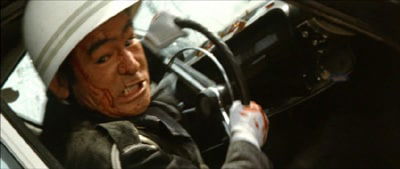
Violent Panic: The Big Crash features plenty of big-name actors of its day. The most well-known of them were perhaps Takuzo Watanabe and Yayoi Watanabe.
Takuzo Kawatani plays the horny police officer pursuing fellow officer Kuriyama (Yayoi Watanabe) before he finally gets crazily determined to catch robber Takashi.
Kawatani (1944 – 1995) was born in Japanese-occupied Manchuria, China. He acted in about 56 movies between 1967 and 1995, mostly playing a villain or odd police officer. He is perhaps most famous for his roles in Kinji Fukasaku’s Battles Without Honor and Humanity but also acted for example in Nagisa Oshima’s Empire of Passion (1978).
Yayoi Watanabe (born in 1952) acted in many Toei Pinky Violence films throughout the 1970s, most famously in several movies of Toei’s Female Prisoner Scorpion series. In 1978, she married legendary sumo wrestler Kurama Tatsuya and retired from her screen work.
Osaka Locations
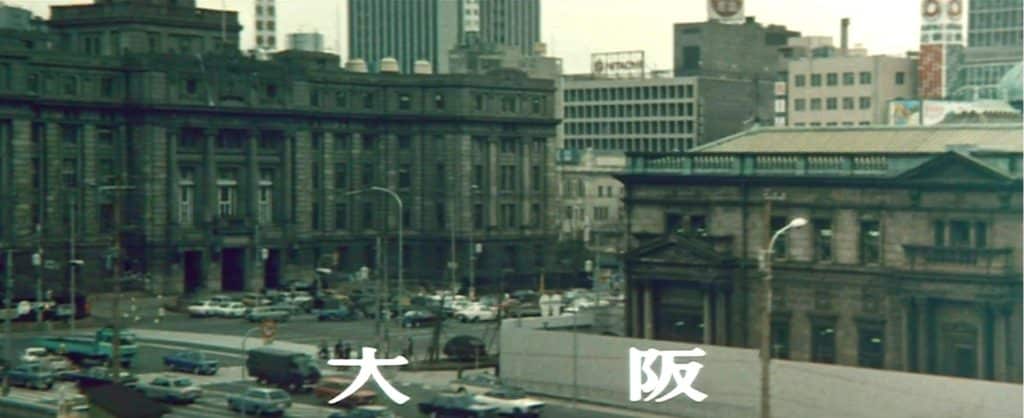
All cities the movie is set in are clearly labeled, documentary style. Once the story moves to Osaka, the city is introduced by a partial shot of old City Hall on Nakanoshima. Old Osaka City Hall was in service from 1921 to the early 1980s. Starting in 1982, it was slowly torn down. Today, the current City Hall stands at its site, in operation since 1986.
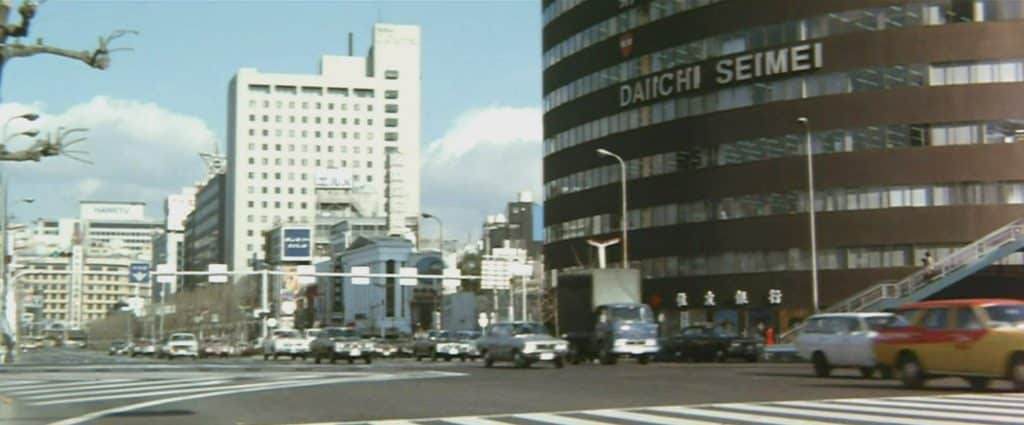
The other remarkable vintage Osaka site in the movie is the old Daiichi Semei Building in Umeda. Daiichi Semei (Daiichi Life) is a large insurance company, the Sumitomo Bank branch on the first floor Takashi robs in the movie is most likely fictional.
The airport featured is supposedly Osaka Itami Airport. No clearly identifying signs are on display, however. Today serving solely as domestic airport, Osaka Itami was the main international air hub for the Kansai Region from the 1950s to 1994, offering flights to all major Asian destinations as well as direct flights to the U.S. and Australia. In 1994, newly constructed Kansai International Airport took over that role.
Osaka is the main setting of the film and Osaka dialect is the main language spoken. Aside from the buildings mentioned above, no famous Osaka sites are on display. There is no Osaka Castle, no Dotonbori, no Shin Sekai. The Osaka of the movie is an Osaka of raunchy bars, non-descript modern concrete structures, industrial warehouses and muddy riverside wastelands.
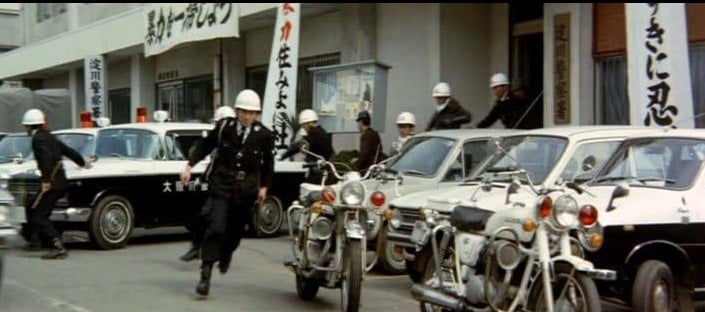
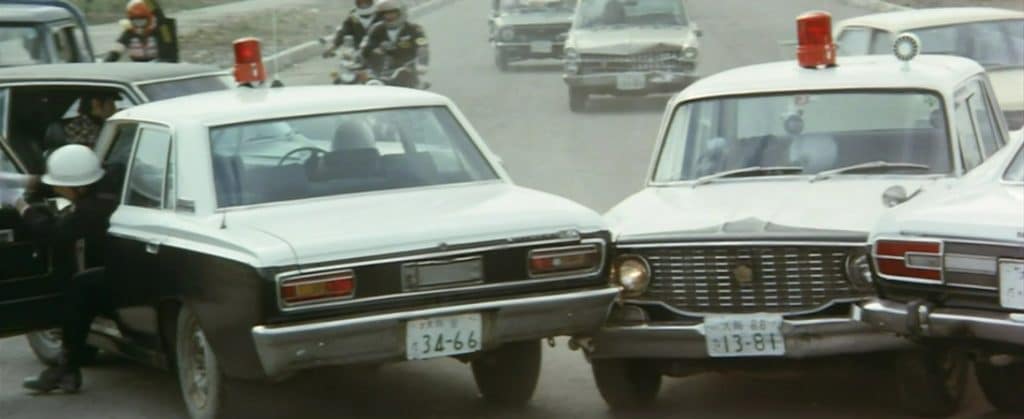
Plenty of Osaka police cars are in view, in all states from perfectly functional to utterly destroyed. If you like to see Osaka police cars crash, this movie is for you.
